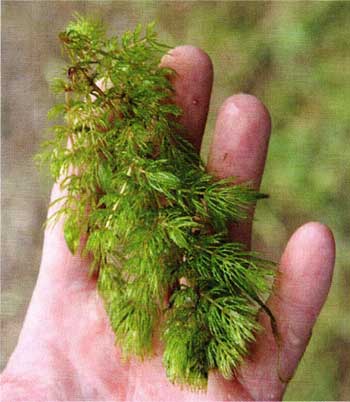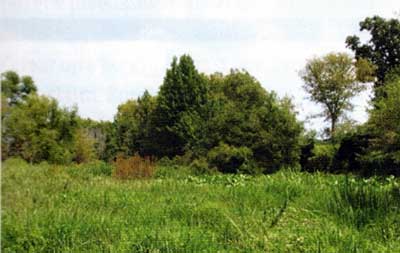
Not long from now, enquiring pondmeisters will want to know. Aquatic plant conversations will rule pond professionals' airways, emails, and phone lines nationwide. The typical conversation starts off, "We have this gooey, green moss in our pond, and every time we cast a line, we snag this slimy stuff. It's gotta go". Then, "What do we do to get rid of it?"
I remember a scene from the movie Pure Country. George Strait, playing the role of Dusty, said to Rory Calhoun, his love interest's dad, "I guess I can see what you are saying." The crusty dad looked at him, pounded the breakfast table, and said, "You guess? NEVER guess. You gotta know. You gotta KNOW what you're doing. If you guess, you're leaving yourself wide open to suggestion..."
That's how folks in the pond management business feel about aquatic plants. You gotta know.
Start off looking at your aquatic plants from the 30,000-foot level. First, remember that 20-30% of your pond needs to be a prosperous habitat for your water's healthy ecology. Fish need what fish need. Insects need what insects need. Life has needs. You've got a healthy pond if your pond has that much habitat. Of that surface area and volume of diverse habitat, up to half can be aquatic plants...as long as they are native, healthy, non-invasive species. There's the rub. Plants grow, expand, and increase density. When that happens, we have to make a judgment call. Guys like me get those phone calls if too much of the wrong area becomes covered with too much plant life. Same when the right area becomes overwhelmed with too much of the wrong kind of plants.
Aquatic plant management is quite subjective. My opinion may matter less than yours, especially if we are talking about your pond. If you think there are too many plants, what a pond professional thinks may be less critical. Enlightenment is next. If you want to swim off the dock and the pondweed mats are frightening, we need to do something. What the biologist thinks is less relevant and matters less if it matters more to you.
But you called us, right?
That means we are dealing with a problem.
Someone's thought process needs to shift. Common ground, if you will. The pond pro needs to understand the pondmeister's position and the dilemma. The pondmeister needs to understand how plants work, what their roles are, and which plants are necessary compared to those that are invasive to lean on the pond pro for the best advice.
Steepen your learning curve to form smarter opinions. And get ahead before plants become a problem.
Several fundamentals are at play here. To bring the discussion closer to Earth by about 20,000 feet, first, understand there are three basic categories of plants. There are submersed species, emerged plants, and those that float. Each category has hundreds of species, each with its quirks and needs. If your pond better fulfills the need and your latitude presents the opportunity for certain plants, and the impetus is there, you'll have plants.
Here's what all those words mean. If you have sunlight, food, and temperature for those plants, they'll grow. Management protocol revolves around manipulating those three key ingredients. You can't do much about the temperature except be aware of which species your pond tends to grow and be educated about that plant's lifestyle and temperature requirements—and pay attention when the temperature window opens. Food may be something you can manipulate. Keep the food deeper than the plants like to grow. That's shallow topsoil and a buildup of organic stuff that accumulates in your water. But you have several choices for minimizing sunlight penetration in your water. A plankton bloom goes a long way to keeping rooted plants at bay.
So much for prevention. But, that's usually the least expensive management strategy.
Once you have plants that are becoming annoying, you have a few choices. Those decisions are based on which plant or plants you have. Your job, dear pondmeister, is to identify those plants correctly. There are books and online searches that can assist this journey. Until you have your plant's absolute, true identity, it isn't easy to figure out what to do about it. Some plants can be physically removed with some degree of effectiveness. Others can be managed with triploid grass carp, also called white amur. Some species need treatment with approved herbicides.

Here's where things get a wee bit ticklish.
Identify the problem. Identify the plant.
Quantify. Don't let the plants get ahead of you. Instead, stay ahead of the plants. Once you wrap your brain around the problem, then come up with the best material and method to keep them at bay to your desires.
Like our long-time friend Cleon Almond says, "Sounds easy, does hard."
When we watch plants grow, it's akin to watching water boil. It takes a while, then when it's boiling, it's too hot to stick your finger in it. Spend time this spring checking for plants. It's a fun exercise, with a fishing pole, a heavy slab with a treble hook, and casting into areas where you want to see if plants are growing. Cast, retrieve, and look at the hook. When you see a sprig, look at it. If you know what it is, congratulations. You are ahead of most of the class. If you don't know what it is, take a photo and then spend time identifying it. Then, learn its habits and compare them to what your pond offers for that plant's success. If you have what it needs, it will grow and can quickly get out of hand. Take time to identify as many species as you have. Then, learn what those plants need and see if your plant has those criteria. If so, you will soon be blessed with overabundant plant life...unless you take steps to prevent it. See the criteria for growth above.
At this point, you can likely be proactive rather than reactive. That's a key to successful plant management.
Be aware. That's your starting point.
Next, learn your management options based on what you project the plants will do in your waters. Then, you've got the impetus to create a plan, a strategy. You will be way ahead of your underwater garden if you can do that. A good goal is to learn how to mix the variables in your brain, leaving enough of the right kind of plants to enhance habitat while keeping plants at bay that inhibit the enjoyment of your experience.
Sounds easy, huh?



